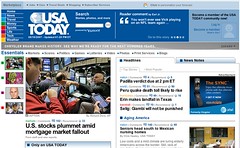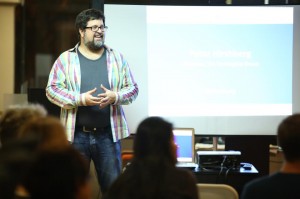 I tried something new this morning and was reading TechMeme on my commute to work when I noticed this story about USA Today’s declining page views since reinventing itself and adding a social network function on TechCrunch.
I tried something new this morning and was reading TechMeme on my commute to work when I noticed this story about USA Today’s declining page views since reinventing itself and adding a social network function on TechCrunch.
Mike did a great job of supporting his claims by including metrics from both Compete.com and Comscore (both have their statistical ‘anomaly’ problems), which clearly points to a real decline. The reason why was left up to the commenters, and many pointed to
- bad redesign
- failure of social networking
- aggressive ad deals
- core audience not wanting to participate (failure to understand audience desire/needs)
- decreasing quality of content
- increased competition
- the change was too drastic
These all are valid concerns, but as I posted in my comment there, which I am reposting below with additional thoughts, I think they miss the bigger picture.
Content is important, but context is king. What is the context of USA Today‘s coverage, shallow dives across a broad spectrum of topics for the entire USA [wasn’t it supposed to be like the McDonald’s of news?]. Their brand has always been about this and people know it. Worse still, they are always trying to make everyone happy, which ultimately makes a lot of it (the content) very mediocre and less appealing – a downward spiral really. With the increasing “nicheification” made possible in digital media (and evidenced by the need for all the different Crunch brands), what is the context for passion, attention and interaction within a USA Today? [or rather, why would I want to join their community?]
The other major trend for context is the move to hyperlocal. Gannett is doing a great job with this in many markets (see the latest Wired article) and I expect that much of that will ultimately bubble up. In short, they should not let go of this experiment unless they want to hang on to the core brand value they established over the last several years.
This is not a failure of the Social Network + Traditional Media model, it is a failure of USA Today to be aggressive enough with rethinking their brand and innovating to serve the needs of their core audience and expand the definition of their audience.
Yes, they did not consider the impact of the radical redesign on their existing audience – Yes, their core audience is mostly part of the 90% from the 1/9/90 rule – Yes, they have alienated a portion of that audience and are losing SOA with them (Share of Attention) [need to go deeper into this idea in another blog post soon]
So what are they doing to encourage participation from those who are there? How are the identifying and supporting the contributors? How are they themselves joining the conversation?
As a final point, it is important to remember that the key facets of personalization for setting proper context have always been geographical and topical. Where someone lives and what they care about. The right mix of context setting is as much art as it is science. USA Today’s state by state news page and their local sports coverage was one of the first to teach me this important lesson over a decade ago. I still think the traditional newspapers have figured out a lot of things that can benefit our thinking 2.0, despite all of the other baggage and often slow pace that considered, researched thinking begets (and the many mistakes that it avoids).

#1 by Tish Grier - August 16th, 2007 at 14:13
Hi Chris…many of the questions you asked (So what are they doing to encourage participation from those who are there? How are the identifying and supporting the contributors? How are they themselves joining the conversation?)are the exact questions that must be answered in any news or marketing project that will attempt to be part of the social networking landscape (see my post here.)
Now, I know these things from actually working on a “crowdsourced” journalism project and from over 10 years of online social activity. Problem is, from those I’ve encountered, is that there are scant few in the news industry who have ever been *actively* and on their own time, involved in the online social landscape. Some have done it as part of their jobs–and that being the case, have had to maintain that journalistic level of “objectivity.” That’s a far different way of interacting than when one’s doing it on one’s one time, and with the acutal goal of making friends (or dating.) The few folks that actually *get* this are, right now, stretched a bit thin (I know some of them) and the news industry is often not all that willing to bring in those who can teach interaction (esp if they’re not also IT people who can fix the back end of things or are journalists.)
Let’s face it: online interactivity requires a new social skill set. But getting the insiders to acknowledge this is a difficult thing.
#2 by Jeremiah Owyang - August 16th, 2007 at 14:55
Great points Chris, it’s great to see you blogging today!
#3 by Chris Heuer - August 16th, 2007 at 15:39
Really great points Tish. It is a totally different mindset required and too many people fail to allow themselves to see these things from another person’s point of view. I remember pitching one ‘insider’ on an idea I had a year ago and they said it would never work – why? because they would never use it themself… but it wasn’t for them, it was for a mainstream audience. Of course, someone else did it and it did work…
Your other point is most important – “social media” is something you need to experience directly to really understand. Pete Blackshaw drives this point home in one of his standard presentations – that he did not really ‘get it’ until he had an offline interaction with family as a follow on to something he wrote online…
Bottomline – its a complex and messy business – its the human condition and is not easily codified – getting collaborative/participatory media right is a real art with few Monet’s and a lot of caricature artists in the business…
#4 by Geoff Livingston - August 16th, 2007 at 18:41
Proof’s in the pudding. When I see 200+ comments on a story two hours after the bell closes:
http://www.usatoday.com/money/markets/2007-08-16-world-markets-thur_N.htm
then I am inclined to believe that the USA today is successful. They don’t need to comment or reply to comments. It’s not right for us to enforce blogging dynamics on a different form of social media.
As far as the nature of their coverage, bland, vanilla, etc. I see no difference between this and some of the junk A-List bloggers serve up.